Featured Students:
Irene Azurmendi | Kiara Bell | Nadia BenAissa | Joanna Bigelow | Michael Brisbane | Cassie Davis | Sheridan Danquah | Sarah Driver | Julius Echipare | Angela Endres | Liam Garrett | Sonali Ghante | Emily Godfrey | Jaylan Hall | Jaylan Hall | Kyle Hartford | Keren Herrán | Sam Herring | Ashley Kellogg | Ayodele La Veau | Nguyet Le | Rosie McNeely | John Motavalli | Paul Ocone | Julia Palmer | Samantha Papastephanou | Crystal Parry | Bella Possidente | Meredith Power | Alex Schobitz
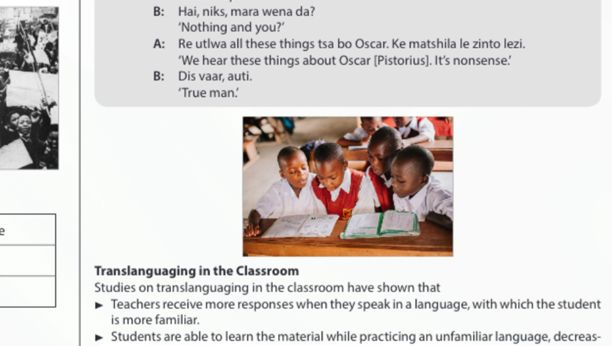
Learning In A Multilingual World: South Africa
Irene Azurmendi, Nicole Barkley, Johanna Caba
Irina Golubeva, Modern Languages, Linguistics, and Intercultural Communication
South Africa has a long history of multilingualism with its multitude of indigenous languages and the history of colonialism and apartheid. It has eleven official languages, nine of which are indigenous to South Africa, as well as English and Afrikaans. Multilingualism and translanguaging are common outside of the classroom, but have only recently started to enter the classroom on a wider scale. The information gained from a real world application of translanguaging can help other countries learn how to create a culture and systems that support a wide array of languages within a society. This qualitative research has been conducted collaboratively. The data were gathered from various sources such as research papers, news articles, websites, books, and videos. The in-depth study of these sources showed that teachers receive more responses when they speak in a language, with which the student is more familiar; however, students feel more comfortable when translanguaging in a non-classroom setting than in the classroom.
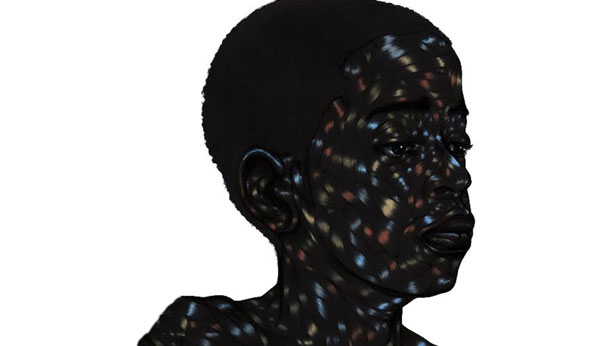
Claudia Rankine’s Citizen: Using Afrofuturist Theory To Examine Themes Of Black Visibility
Kiara Bell
Dr. Maleda Belilgne, Africana Studies
How are black lives today still affected by America’s deep roots in chattel slavery? Christina Sharpe’s book, In the Wake: On Blackness and Being (Duke University Press 2016), studies theories of Blackness as it relates to visibility and aspiration. Sharpe examines cross-cultural representations of Black life to build her theme of “the wake,” which she defines as the climate of anti-Blackness that shapes post-slavery America. I will use the Afrofuturist theory from two chapters of Sharpe’s book, “The Hold” and “The Weather,” to examine elements of Black visibility in Claudia Rankine’s experimental book, Citizen (Graywolf Press 2014). A central tool used by Sharpe is the use of ‘Black annotation’ and ‘Black redaction’ to offer an alternative reading of how information is presented, past “the logics of the administered plantation.” The definitions she presents of ‘Black annotation and reaction’ can be used to analyze scenarios of Black aspiration in Citizen. Both authors use the aforementioned tools in their writings to address Black visibility. Using Sharpe’s theoretical work on ‘anagrammatical Blackness,’ ‘Black annotation,’ and ‘Black redaction,’ I will explore how Citizen promotes themes of Black visibility in “the wake.”
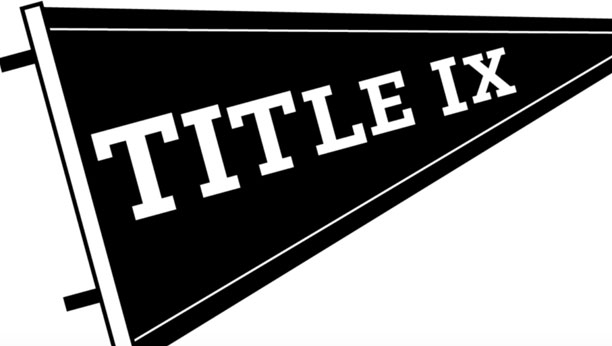
A Cultivation Of Rape Culture In D.C., Maryland, And Virginia Universities
Nadia BenAissa
Kate Drabinski, Gender and Women’s Studies
The normalization of sexual violence is known in the literature as rape culture. Four year universities in the United States have historically cultivated rape culture. The public has a vested interest in knowing what is or is not being done to dismantle rape culture and prevent sexual assault on campuses, in order to hold these institutions accountable. The scope of this research was select universities within the D.C., Maryland, and Virginia area. This research recognizes commonalities within the cross populated universities that cultivate rape culture and identify how inconsistent metrics have left universities unaccountable. A social constructionist and mixed methods approach was used to explore how institutional betrayal has exacerbated the problems with campus climate surveys and further distanced people of color and LGBTQ+ individuals from reporting. An archival analysis of university policies, rape culture, and Title IX was conducted, along with a statistical analysis of campus sexual assault surveys. The archival analysis suggests that despite updates to laws/policies, universities have failed to reach their more diverse populations. The data analysis suggests that the differing modes of surveying campus climates has led to statistically insignificant results that cannot affirm that new university sexual violence policies are working.
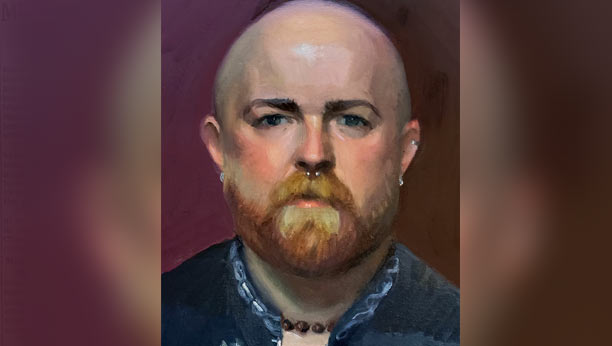
Portraits: An Exploration Of The Human Spirit
Joanna Bigelow
April Householder, Undergraduate Academic Affairs
My goal in creating a piece of art is to convey the truth that lies in beauty. My focus in my work is creating solid forms and expressing rhythm in the face and the body. My style is a mix of realism and impressionism. I work primarily with charcoal and oil paint, but I am also adept at working in digital media and 3-D design. My medium and approach are often seen as traditional, but I desire to show the sacredness of nature and humanity. I am always in a state of learning. My approach is to constantly re-invent and conceptualize the way I see things. My work, as a result, has a life of its own and a sense of balance.

What Is The Effect of The Writing Center as It Relates to Transfer Students and Persistence?
Michael Brisbane, Mary Gallagher1, Rose Jackson2, Ira Degawan3, Kevin Curtin3
1Macklin Center for Academic Success, USG, 2Office of the Executive Director, Universities at Shady Grove, 3Psychology, UMBC
Diane Alonso, Psychology
University transfer students may not be as equally likely as non-transfer students to utilize student services such as the writing center due to demographic and academic characteristics. In this sense, transfer students could be seen as having less access to resources and academic support, placing them at a higher risk for attrition. Attrition (or persistence) research examines the factors and mediating roles associated with student completion or graduation rates. Two related factors of paramount importance are self-efficacy and self-regulation, defined as the feelings about one’s ability to achieve a goal, and to plan, organize, and carry out the objectives of that goal, respectively. This study explored the relationship between transfer students’ characteristics, writing center usage, and persistence. Implementing a mixed-methods approach, self-report measures were used to gauge writing self-efficacy and self-regulation levels. Additionally, qualitative methods adopting the phenomenological approach were implemented by conducting interviews with 20 students to yield themes associated with high and low writing center usage. The qualitative research expanded and elaborated on the transfer student experience with the writing center.
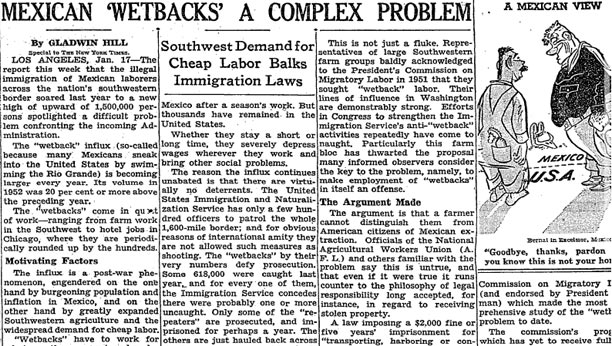
Implications Of Rhetoric: A Historical Newspaper Analysis Of Immigration Policy
Cassie Davis
Tamara Bhalla, American Studies; Sarah Fouts, American Studies
Nativism stems from an adverse reaction to immigration in the US, resulting in exclusionary immigration policies. This project studies nativism and racialized rhetoric surrounding immigration to identify parallels between the Trump administration’s Muslim ban and restrictive immigration rhetoric and legislation in three other periods of US history. The legislative policies were chosen to represent a range of racialized experiences, as well as the indiscreet, racialized, and pejorative language used within the policies themselves. By comparing the rhetoric underpinning exclusionary policies of the Chinese Exclusion Act, Operation Wetback, and IRRIRA/IIRIRA, this research will demonstrate how language connected to these policies is used to justify the discriminatory and inhumane treatment of immigrants in the US. Given that the breadth of sources is so vast, this project has only focused on rhetoric appearing in the New York Times. Additionally, this study examines scholarship on American nativism to analyze how such rhetoric describes migrants as criminal, amoral, or less-than-human, to justify biased and inhumane treatment of these potential migrants and encourage anti-immigrant sentiment among Americans.
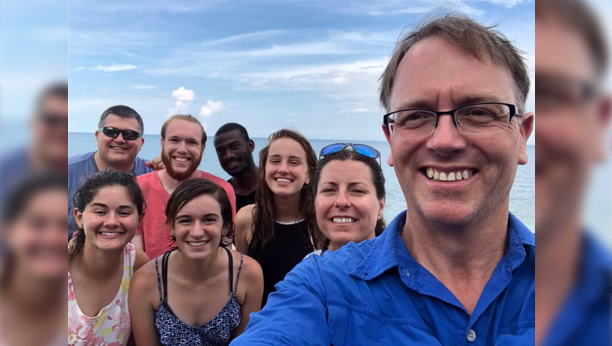
Use Of Radio Tracking To Study Territory Size Of The Bahama Oriole
Sheridan Danquah, Gabriel Wilkins, Breanna Byrd, Sierra Barkdoll
Kevin Omland, Biological Sciences; Matthew Fagan, Geography & Environmental Science, UMBC; Colin Studds, Geography & Environmental Science, UMBC
The Bahama Oriole (Icterus northropi) is a critically endangered birdfound only in Andros, Bahamas. Previous literature on these orioles suggested they mostly nested in developed areas in Coconut Palms (Cocos nucifera). With new knowledge that the Bahama Oriole also nests in pine forests (Pinus caribaea), we hope to make more accurate population estimates. Determining the territory size of the Bahama Oriole is crucial to making reliable population estimates.
Using radio transmitters placed on three different orioles, we triangulated the positions of tagged birds. These positions were used to generate territory maps for the three radio tagged orioles. To assess the validity of our equipment, and ensure the transmitter was still on sampled birds, we also periodically set out to sight the tagged orioles. The resulting home range maps show that the Bahama Oriole has a larger territory size than was previously assumed. These findings will be crucial in our ongoing efforts to estimate the total number of Bahama Orioles surviving.
This investigation was sponsored by NIH/NIGMS MARC U*STAR T3408663 National Research Service Award to UMBC.
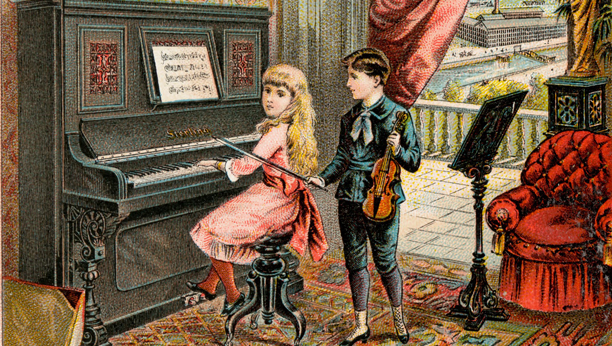
The Domestic Pianist: The Impact Of The Parlor Piano On Middle Class Domestic Life In Nineteenth Century America
Sarah Driver
Melissa Blair, History
In nineteenth-century America, the parlor piano carried immense symbolism. The piano represented wealth, taste, position, and duty. My research explores how a large, cumbersome instrument aligned itself with the most influential, but intangible aspects of everyday life for the nineteenth-century middle class American. Inside the home, the piano had a significant impact on interior design, family dynamics, and gender roles. It showed visitors that their hosts were a strong family with a hardworking husband and father, a stylish, caring wife and mother, and disciplined, cultured children. Meanwhile, outside the home, these compact pianos played a major role in American manufacturing, commercialism, and consumerism while also bringing about the birth of the modern music industry. By understanding the role of the parlor piano in nineteenth-century America, one cannot only learn a great deal about American culture and society of the period, but also appreciate how much of an impact everyday objects have on modern life and the stories they will be able to tell in the future.
This work was funded, in part, through an Undergraduate Research Award from the UMBC Division of Undergraduate Academic Affairs.
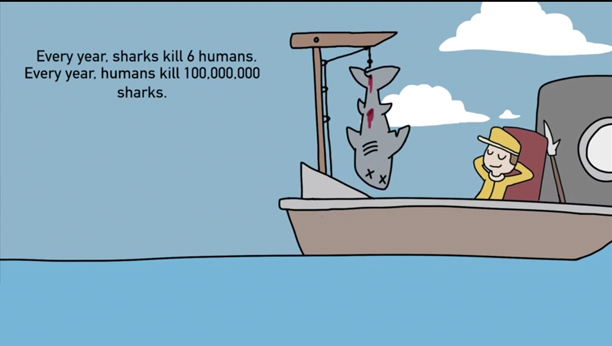
Sea Monster
Julius Echipare
Corrie Parks, Visual Arts
Sea Monster is an animated PSA that uses hand drawn animation and is 1:14 minutes long. It depicts a role-reversal of a common scene, a shark attack on a nice day on the beach. Marine wildlife is a strong fascination of mine and this animated PSA’s purpose is to show viewers the endangered state that sharks are in. Many endangered creatures are given constant attention, but I don’t see enough press about sharks. I believe it is because unlike pandas or sea turtles, people think that sharks are one of nature’s super predators, monsters that don’t need our help to live. This animation will show who the real sea monster is. After developing a storyboard, I used a drawing tablet to bring my ideas to life in Adobe Photoshop. Each scene was drawn and colored in separate Photoshop files and assembled using Premiere Pro. A calm building quickly to a dramatic climax and ending abruptly, similar to a storm at sea. The animation plays on the emotions and informs viewers on the topic of shark endangerment. Drawing and animals are two of my most favorite things and using both to entertain and spread awareness made me passionate about this project.
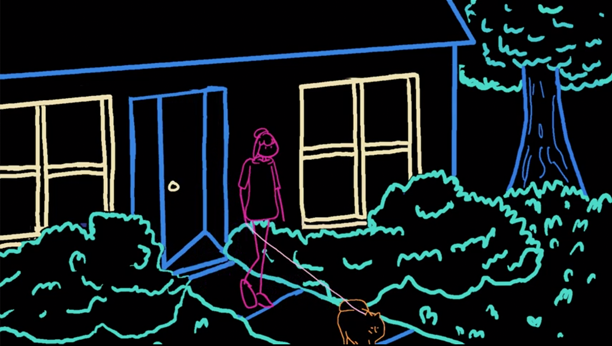
Sirius: An Animated Short
Angela Endres
Corrie Parks, Visual Arts
Sirius is a 1:07 minute digital animation about a girl walking her dog at night, enraptured by the starry sky. This is a self-portrait about how I love stargazing and find myself doing it while walking my dog. I also created this piece as a way of showing how the feeling of fascination or admiration can make one forget about the world around them. The audio is original with sound effects coming from the actual sources in real life. The music in the film, Mariage d’Amour, was covered by Tracy Yang; this piano piece added an air of beauty to the transition scene. The rest of the musical elements were created using Ableton Live 10. Rotoscoping and hand-drawn animation techniques were utilized and done entirely with Adobe Photoshop. I shot video reference of myself and my dog as part of the process, which allowed me to capture both of our movements and personality realistically. It was important to make sure the two techniques of hand-drawn animation and rotoscoping combined seamlessly and that the transition to imagination can be understood. The result is an engaging animation that portrays this experience in a way that cannot be done in real life.
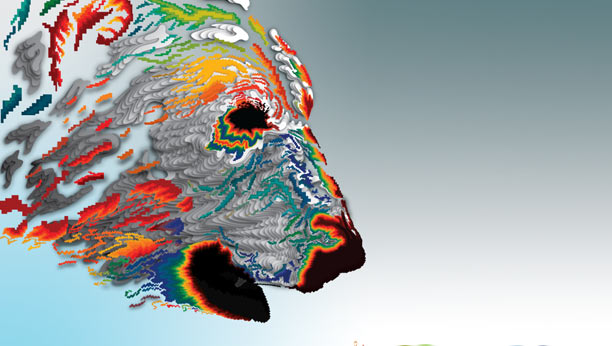
The Digital Art Movement: Its Role In Spreading Awareness About Endangered Animals
Liam Garrett
April Householder, Undergraduate Academic Affairs
The new Digital Art Movement has been about showing viewers the artistic capabilities of machines, and using the internet to raise awareness about issues such as climate change and endangered animals. As the founder of The Digital Art Movement at UMBC, it has been my ambition for almost three years now to create digital art pieces that reflect who we are now, and the issues our generation faces. Using metaphorical imagery, and patterns (chosen because these are visual attributes we are built to scan and read into,) I have created a series about endangered animals that is built to be interpreted, and affordable. With 15% of profit going to the World Wildlife Fund (WWF), my hope is that digital art can play a role in the cause to better our environment and protect its animals.In this presentation I will to share my experience with the digital art medium and its role in the future of art. With the world delving deeper into the digital realm every day, it is my belief that digital art will soon be of major interest to the art world. Art is the practice of exploration and expression, and the digital world is the new frontier.
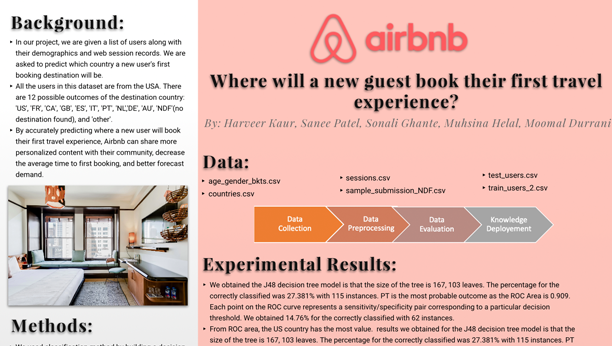
An Analysis of Where a New Guest Would Book their First Travel Experience
Sonali Ghante, Harveer Kaur, Muhsina Helal
James Foulds, Information Systems; James Foulds, UMBC
Machine learning, data mining algorithms and data analytics were discussed, researched and implemented. In a collaboration of a team of 5, data analytics were performed on datasets from Kaggle through utilizing data mining tools such as Weka and Rapidminer in order to gain insight into where a new guest would book their first travel experience. A supervised learning approach along with decision trees, random forest classifiers and the ROC curve were utilized on the Airbnb data provided by Kaggle in our project. Data pre-processing, data collection, and data evaluation on the various datasets provided by Kaggle were implemented. After conducting the data mining algorithms using Weka and Rapidminer, the Random Forest Classifier and Decision Tree algorithm provides the most accurate results. Age, language, month of the first booking and gender were the major features that gave the most insight and analytics into where a new guest will book their first trip. Overall, data mining methods and algorithms proved to determine where a new guest will book their first travel experience for Airbnb guests.
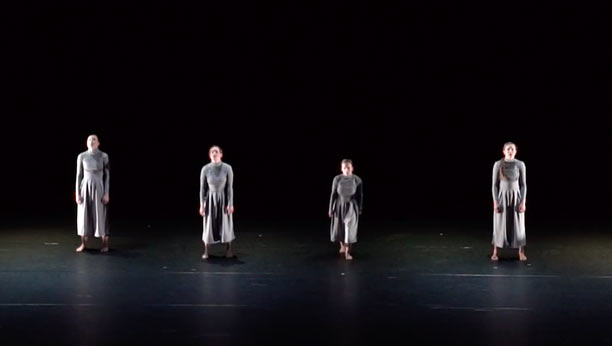
“terminal”: Contemporary Choreographic Perspectives
Emily Godfrey
Carol Hess, Dance
“terminal” is a dance that explores the individual choice forced upon family members when a family dynamic is drastically changed forever. The work was researched and created for the Senior Dance Concert (November 2019), performed at the Fall Dance Showcase (December 2019), and will perform again at the “American College Dance Association” in March 2020. The inspiration of the work derived from observing the different ways a family reacts to the slow passing of a loved one that once connected the community. While the movement and placement of the dancers should somewhat show the original and intended message the choreographer envisioned, the audience is given the choice to create their own meaning to the dance, derived from what they experienced. Emphasizing the dimensionality from a range of minimalistic gestures to athletic locomotion, four dancers show a wide range of movement vocabulary to express confrontation, intimacy, and the feeling of imbalance. The piece is intentionally left open-ended, leaving the audience to reflect, react, and invoke discussion. So long as the work resonates with the viewer, the experience is what matters, not the presentation of a theme.
This work was funded, in part, through an Undergraduate Research Award from the UMBC Division of Undergraduate Academic Affairs.

Development Of A Custom Robotic Actuator – Quadruped Robot Project
Jaylan Hall
Fow-Sen Choa, Computer Science and Electrical Engineering
The quadruped robot from last year’s URCAD utilized off-the-shelf servo motors to perform simple movements such as standing, walking, pivoting, and a unique walking/wheeled feature. For the new version, a quicker, more forceful actuator is needed in order to achieve running and jumping behaviors. The current market options are either too expensive, require too much power, or in most cases, both. To solve this problem, a custom-designed, fully 3D printed, robotic actuator was developed, capable of outputting fast, forceful movement. Costing under $40 to prototype, this actuator presents a compact size, low weight, easy assembly, low power requirement, simple programming, finished with an attractive aesthetic. Amid the version 3 redesign, the motor control system was made independent of the robot’s higher level control, allowing it to allocate more processing towards its higher level behaviors (inspired by mammal nervous system). In addition, an artistic touch was highly more integral throughout the design process, pushing away from the industrial build of the majority of current robotic systems. The next steps for this project involve development with basic and intermediate maneuverability, environmental perception and navigation, and most excitingly, exploring the unique fusion of emotion and logical reasoning.
This work was funded, in part, through an Undergraduate Research Award from the UMBC Division of Undergraduate Academic Affairs.
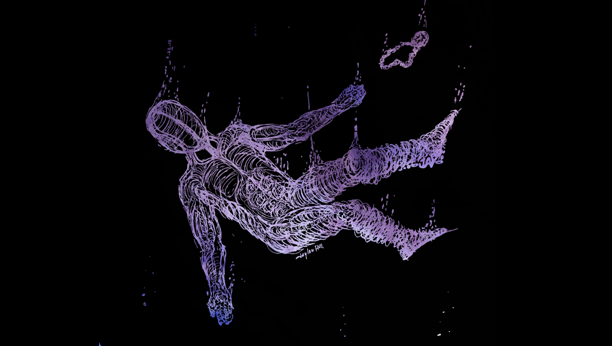
A Peek Inside the Vault: Digital Prints
Jaylan Hall
April Householder, Undergraduate Academic Affiars
I create abstract visuals that spore from the depths of my greatest anxieties, desires, insecurities, and passions. Hidden throughout the compact lines and curves, you will find a mixture of bold and minute details that expose my internal thoughts and emotions in their most raw form. Common inspiration for my art style tends to draw from the stark contrast between nature and technology, along with depictions of isolation, introversion, and overthinking. A major source of gratification for me is listening to what people see when they look at my art; It is as if I am alongside the creation of a new piece each time. Every single person thus far has abstracted a meaning unique to their own personal experiences, desires, and emotions. My mediums usually consist of portrait paper, touched with varying thicknesses of black ink pens, and sometimes filled with colored pencil. The more recent of my works combine digital editing, musical underlays, colorful tones, and movement, creating newfound dimensions to the abstracts. My need to create is an ultimate function of my coping mechanism to the pushes and pulls on my experiences.
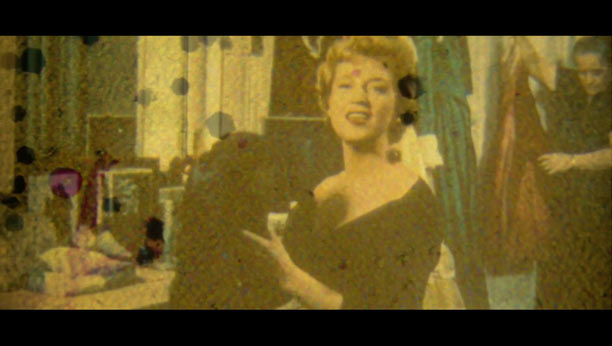
The Last Roadshow
Kyle Hartford
Cathy Cook, Visual Arts
A roadshow was a special presentation of a film used in the golden age of Hollywood. This piece is meant to be a worn-down, deterioration of a roadshow release. The medium of film has changed. People are no longer amazed by a moving image, no matter how beautiful. I searched in the film archives of the Visual Arts department and found a beautiful16mm print of a documentary about the making of the Lincoln Center in New York. In this footage, we see famous soprano Risë Stevens, who also appeared in many golden age Hollywood films such as Going My Way. I found this footage mesmerizing and tragic. The technicolor took me back to another time. I wanted to give viewers this feeling for the beginning of the piece. Slowly, I start to implement more aggressive visuals. I painted onto 16mm analog film strips and digitized the archive footage as well as the archive footage. In order to view the film reels before a digital transfer, I loaded the reels onto a Steenbeck. With the digitized footage, I faded the archive footage into the painted strips. This is meant to symbolize the death of a more innocent time in cinema.
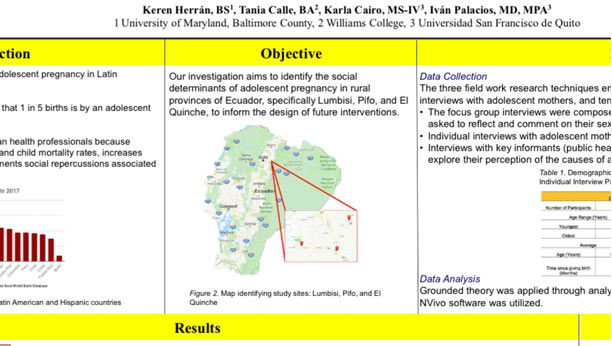
Children Raising Children: A Qualitative Study Of The Social Determinants Of Adolescent Pregnancy In Rural Ecuador
Keren Herrán, Tania Calle1
1Williams College
Iván Palacios, Universidad San Francisco de Quito; Rebecca Dillingham, University of Virginia
According to Ecuador’s most recent census, 1/5 of pregnancies are from adolescent mothers — elevating rates of poverty, maternal and child mortality, and birth complications. Hence, our research question: how do social determinants of health (SDOH) cause adolescent pregnancy in rural Ecuador?
Our research team analyzed 3 focus groups composed of 5-7 adolescent (14-21 years old) mothers who had recently (within two years) given birth in El Quinche, Lumbisi, and Pifo. In depth interviews with 10 key informants (health officials, providers, and policy-makers) were also organized to explore perceptions regarding interventions and causes of adolescent pregnancy. Our team interviewed until reaching saturation of information, validating collected data through triangulation. We applied grounded theory for analysis via open, axial, and selective coding using NVivo software.
Our data revealed that the root SDOH causing adolescent pregnancy includes compromised sexual education, shame in discussing the topic, and troubled households. Therefore, we recommend that Ecuador focus on improving the quality of sexual education in schools, creating a positive sexual environment, and encouraging female empowerment. Ultimately, gaining a better understanding of the causes of adolescent pregnancy can inform the formulation of more effective interventions in Ecuador and beyond.
The project described was supported in whole or in part by the National Institute on Minority Health and Health Disparities of the National Institutes of Health under award number T37MD008659. The content is solely the responsibility of the authors and does not necessarily represent the official views of the National Institutes of Health.
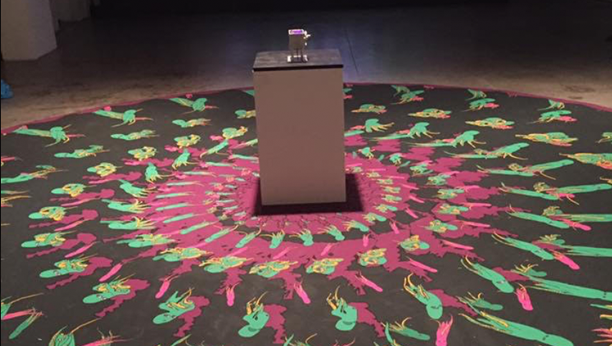
High Definition Real Time Zoetrope (HDRTZ)
Sam Herring, Jd Byron, Silas Dunigan, Matt Vermont
Prof. Eric Dyer, Visual Arts; E. F. Charles LaBerge, UMBC
The High Definition Real-Time Zoetrope (HDRTZ) was designed and constructed to take a stationary artwork and rotate it via image processing to create the illusion of animation. The system was developed as part of the 2019-2020 Computer Engineering Capstone course. The HDRTZ was created in collaboration with UMBC professor and artist Eric Dyer, who created the artwork and helped design the system. The HDRTZ samples a camera feed and rotate the image via software running on the NVIDIA TX2. The image rotation is controlled by an external crank that outputs a voltage proportional to its input. The software then uses rotational algorithms to rotate the image appropriately based on the voltage produced by the crank. Simultaneously, an audio track is sampled at a rate proportional to the crank input to add further interactivity to the art. The system was configured and initialized through an external web application responsible for the centering and masking of the displayedimage.The HDRTZ is intended to be installed in a public setting, so the system was designed to be simple enough that an unfamiliar user can quickly figure out how to interact with it.
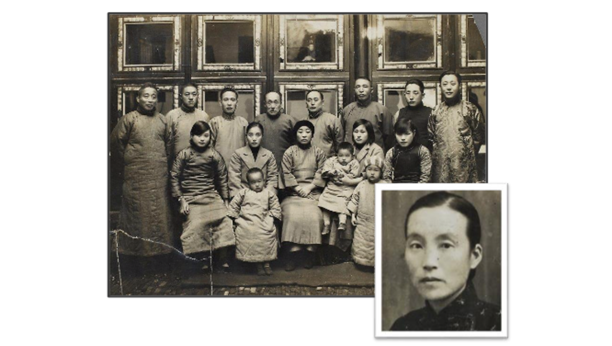
Women In Colonial Korea: The Overlooked History Of Women’s Role In Korean Independence
Ashley Kellogg
Kyung-Eun Yoon, Modern Languages, Linguistics, and Intercultural Communication; Meredith Oyen, Director, Asian Studies Program
When prompted to think of women during Colonial Korea, the image of the so-called “comfort woman” dominates the conversation. While these victims must be remembered and honored, history must also acknowledge the women who participated in protest and disobedience against Japanese imperialism. This research is conducted with the goal to tell the stories of the women often overlooked in the history of Colonial Korea in terms of their contributions toward Korean independence. Further, this research aims to discuss the unique obstacles Korean culture and society would pose to women of the era in context. Examination of text archiving the lives of notable figures and translated memoirs alongside prior studies will set the foundation of this research and reveal the complex and varied lives of women during Colonial Era Korea. Most importantly, this research will reveal the impact women had progressing Korean independence often overlooked in favor of and perhaps despite their male counterparts.

“The Process”
Ayodélé La Veau
Eve Muson, Theatre; Nicole Smith, McCourt School of Public Policy, Georgetown University Center on Education and the Workforce
As a URA scholar, I was granted an opportunity to combine my majors in Psychology and Theatre to explore Art therapy. Art therapy is defined as “an integrative mental health and human services profession that enriches the lives of individuals, families, and communities through active art-making, creative process, applied psychological theory, and human experience within a psychotherapeutic relationship” The purpose of my original study was to gather qualitative data from public secondary schools and creative arts programs within Baltimore City, on the use of the creative process as a means to teach and explore social emotional learning. Due to COVID-19, this portion of my project has been postponed. I took this opportunity to focus on my “why”, and learn more about the creative process and its benefits. I created this video to illustrate the journey from an idea or vision to a final product. Everyone has a different relationship with this journey. Engaging in the creative process is one way to monitor this relationship. There are many nuances and challenges along the way, sometimes we are able to push past them with our own tools and other times, we might benefit from some guidance. Enjoy “The Process”.
This work was funded, in part, through an Undergraduate Research Award from the UMBC Division of Undergraduate Academic Affairs.
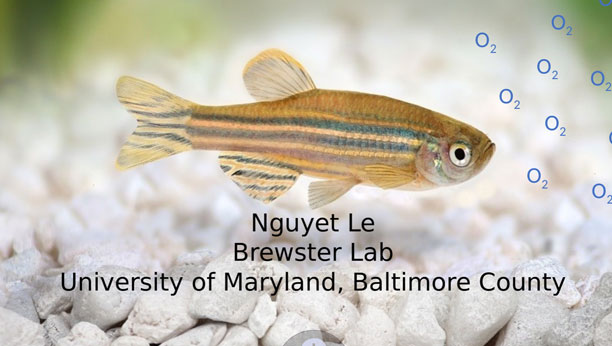
Role Of N-myc Downstream Regulated Genes Family In Low Oxygen Adaptation
Nguyet Le
Rachel Brewster, Biological Sciences
Oxygen deprivation decreases ATP production dramatically. In humans, the loss of ATP in organs with high metabolic rate, such as the brain and kidney, can lead to cell death. However, zebrafish embryos enter a hypometabolic state that enables them to conserve ATP and survive for up to 50 hours without oxygen. Currently, the mechanisms that promote this hypometabolic state are unknown. Our previous mass-spectrometry study revealed a significant increase of lactate concentration in zebrafish under anoxia. Lactate was previously shown to stabilize N-myc Downstream Regulated 3 (NDRG3) in hypoxic cancer cells to promote angiogenesis and cell survival. We hypothesize that lactate/NDRG signaling could also be utilized in normal cells of the zebrafish embryo to arrest ATP-demanding processes and enhance survival. To address this, I investigated the mRNA distribution and transcriptional regulation of NDRG family members. In situ hybridization revealed that NDRGs are enriched in the brain and kidney and expanded to other tissues such as the olfacoty placode and vasculature in response to anoxia. RT-qPCR revealed both up- and down-regulation of different NDRG members in response to anoxia. These studies will shed light on how NDRG family members contribute to low oxygen adaptation in normal cells of an intact organism.
This investigation was sponsored by NIH/NIGMS MARC U*STAR T3408663 National Research Service Award to UMBC.

“Begin Purging State Dept. Of Homosexuals”: The Lavender Scare And The LGBT Community During The Cold War
Rosie McNeely
Meredith Oyen, History
The Lavender Scare was a little-known episode in LGBTQ history in which thousands of gay men and women employed by the federal government in the 1950s lost their jobs due to their sexuality. From this purge, the gay rights movement emerged to fight vigorously for LGBTQ individuals’ ability to work, regardless of their sexual orientation. By examining both government documents and the manuscripts of those involved in the budding gay rights movement, I evaluate how the Lavender Scare came into play and the reverberating effects on the LGBTQ community in the 1950s and 1960s. The Lavender Scare blossomed out of the anti-communist and homophobic paranoia of the McCarthy era and resulted in the termination of thousands of homosexual government employees and major panic in the LGBT community due to the loss of people’s sense of security, but the aftermath gave way to unity in the community and helped lay the foundation for equal LGBT rights in the United States. This research is increasingly relevant at a time when the Supreme Court is deciding a case on whether employees can be discriminated against based on sexual orientation and gender identity.
This work was funded, in part, through an Undergraduate Research Award from the UMBC Division of Undergraduate Academic Affairs.
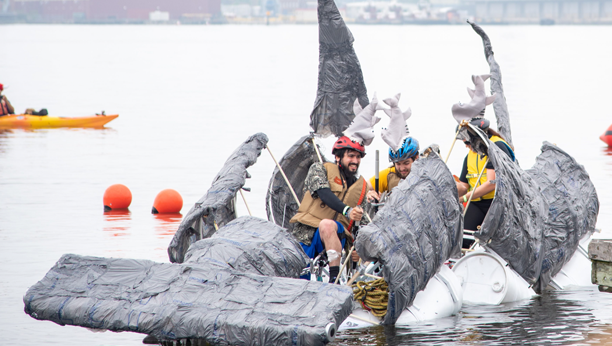
MC Hammerhead: A Kinetic Sculpture Redesign Project
John Motavalli, Tristan King, Susanna Abler
Steven McAlpine, Individualized Study
UMBC kinetic sculpture team members will present an overview of their redesign efforts during the Fall semester of 2019: adding water propulsion, creating a more durable sharkskin out of recycled materials, and transforming pontoons into functional artwork. These design efforts were part of an interdisciplinary course, INDS 430 Kinetic Sculpture Project, which drew upon methods from sustainable design, project management, and biomimicry to build a new 20 foot shark sculpture named “MC Hammerhead.”
This work was funded, in part, by the Alex Brown Center for Entrepreneurship URA Award.
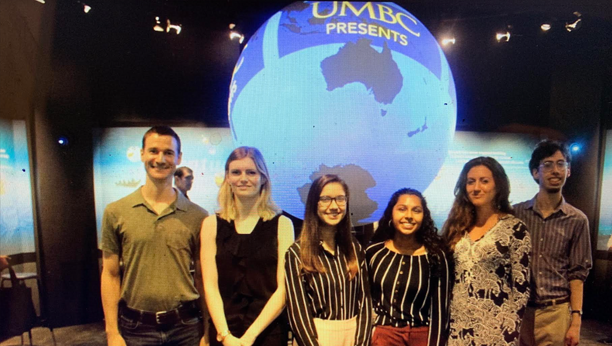
On Thin Ice
Paul Ocone, Lauren Patel, Sangita Ramaswamy, Tori Nelson
Donald Snyder, Media and Communication Studies; Nicole Trenholm, Geography & Environmental Systems, Graduate Student; Ben Daniels, Geography & Environmental Systems, Graduate Student
On Thin Ice is a spherical film that explores the impacts of climate change in the Arctic, a vital region for the Earth’s future. An interdisciplinary team of students used a combination of maps, visualizations from NOAA, videos, and images, to produce an immersive presentation that depicts changes in our world in places not accessible to the public. The team researched the problem, created GIS maps, wrote a narrative, and brought all of these elements together into a documentary made for spherical projection systems. The story follows marine animals of the Arctic, from phytoplankton to polar bears. This exploration provides insight on how a changing climate affects Arctic wildlife and their habitats. On Thin Ice also introduces humans as a part of the Arctic ecosystem and as essential players in determining the fate of the Arctic. This short documentary showcases the use of spherical video for science communication, and it incorporates elements of all of the Polar Literacy Initiative’s Polar Literacy Principles. This makes this video a tool for teachers to use in their classrooms during lessons about the Arctic region, and science museums can showcase the film across the US.
This work was funded, in part, by the Provost’s Office, the Dresher Center for the Humanities, and the Office of Summer, Winter and Special Programs under the UMBC Interdisciplinary CoLab program.
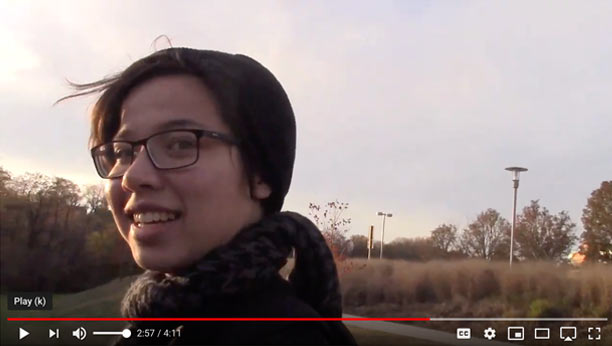
De-Cyborging
Julia Palmer
Tania Lizarazo, Global Studies
My Global 409 class focused on technology’s impact on society. Through reflecting, I discovered my struggle to remain true to my identity, in this age of rampant technology. For my final project I desired to have it change me. I challenged myself to document days without my phone, to De-Cyborg. Initially, I spent more time by myself than usual. Making plans with friends couldn’t be instant anymore. The isolation created loneliness, however, I soon found joy in thinking and processing without distraction. I wrote poetry and surrounded myself with nature; my mind was clear for the first time in awhile. This four minute video invites the audience to explore my internal conversation with my phone, as I refer to it as “you”. In a broader scope I hope the audience will begin to challenge their own thoughts, and question the impact their phone has on them. In the end, I give the final question of “I need you?”. During college, I have chosen convenience over mental health; in choosing to keep my phone. My aspiration for the future is being able to balance life without it, and focusing on what matters.

Goop!
Samantha Papastephanou
Corrie Parks, Visual Arts
Goop! is a fun thirty-second looping exploration of beats, shapes, and colors. The objective of this piece was to capture everything I thought made animation fun to watch: bright and deliberate color palettes, fluid movement, and visual rhythm. I’ve always found pieces of animation paired with music to be incredibly satisfying to watch when done right, and I wanted to try making one myself in the limited amount of time that I had. By creating a looping piece, I’ve made it easier for me to enjoy those key moments where the animation and the music match up perfectly. Not having a theme gave me the freedom to work intuitively and spontaneously with the music, which was chosen before starting the animation so I could carefully plan the visuals. I chose and edited a song titled “Cute Monsters” by Hani Koi because I thought it best complimented my vision of what I wanted my piece to look and sound like. Each frame was drawn by hand in Photoshop, and the limited color palettes were chosen with creating a specific visual effect in mind. Each palette had two “transition” colors that allowed it to connect with the palettes before and after.

IL-1β-VEGF-A Signaling Axis In Atherosclerotic Calcification
Crystal Parry
Alan Morrison, Brown University
Atherosclerosis is characterized by lipid and calcium deposition and inflammation in blood vessels. Pro-inflammatory cytokine IL -1β contributes to inflammation that is characteristic of atherosclerosis. Previous research on signal transducers RAC1 and RAC2 demonstrated that RAC2 knockout mice had increased RAC1 activity, resulting in increased levels of IL-1β and calcification. These studies also focused on studying the growth factor VEGF-A, which promotes blood vessel formation. Preliminary data suggests the promoter region of the gene encoding VEGF-A is activated by IL-1β signaling. The goal of this study is to assess the relationship between VEGF-A, IL-1β, and atherosclerotic calcification. Our hypothesis is that increased levels of IL-1β associated with increased VEGF-A expression and calcification. Enzyme-linked immunosorbent assays were used to determine the levels of IL-1β and VEGF-A in blood serum samples from the mice. Macrophage knockdown of IL-1β expression in ApOE mice led to reduced VEGF-A expression and atherosclerotic calcification. These results were validated by comparing levels of IL-1β, VEGF-A, and calcification in human subjects. Future studies are underway to demonstrate that VEGF-A causes calcification, using knockdown of VEGF-A expression. By understanding the relationship between IL-1β, VEGF-A, and atherosclerotic calcification, therapeutic strategies can be developed to combat atherosclerosis.
This research was sponsored by the National Heart, Lung, and Blood Institutes, the National Institutes of Health, and was partially funded by R25HL088992, RO1HL139795, CPVB COBRE NIGMS NIH P20GM103652, VA-ORD CDA-2 7IK2BX002527 to ARM.

Lighthouse
Bella Possidente
Corrie Parks, Visual Arts
Lighthouse is a two-minute digitally animated short film about a tiny lighthouse keeper doing his job. When a lighthouse is damaged by a violent storm, its keeper must go on a journey to fix it and restore light to the surrounding area. The film was inspired by an odd concept that stuck in my mind—a lighthouse standing alone in a field, surrounded by wind-blown grasses that mimic the movement of ocean waves. By telling one character’s story, the film showcases a very small part of that world. The sound design adds reality to the film and is paired with whimsical visuals to create a strong environmental mood. Having the freedom to record foley and compose an original soundtrack made it possible to match the emotional tone of the story and use the audio as an additional means to communicate information. The visuals make use of simple shapes and limited colors to clearly and efficiently communicate action, setting, and tone. Completing an ambitious project in a short time influenced many design decisions in the interest of making the final product achievable. Ultimately, the time constraint was instrumental in bringing out the level of quality present in the finished work.
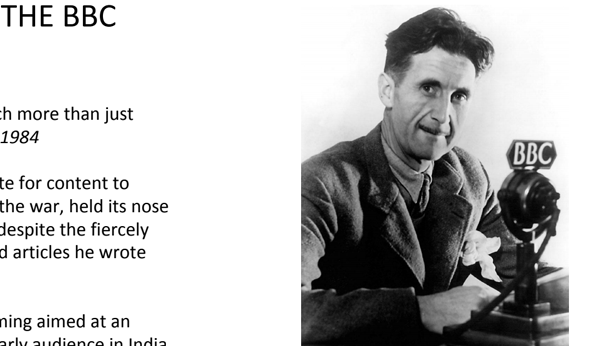
Tracing George Orwell’s Anti-Imperialism In Propaganda Broadcasts By The BBC To India And Southeast Asia, 1941 To 1943
Meredith Power
Daniel Ritschel, History
From 1941 to 1943, the BBC employed a mild-mannered but fiercely opinionated writer named Eric Blair to produce propaganda for broadcasts to India. How did Blair – better known to the public as leftist firebrand George Orwell – reconcile his personal political view with the messages his position required him to send? Scholars and historians often discuss Orwell’s career in relation to his two greatest novels, Animal Farm and 1984. The straightforward prose and the earnest intellectual tone for which his novels became known also served a valuable role in his contribution to Britain’s war effort in India and southeast Asia. Drawing on Orwell’s early fiction, letters, and essays, as well as selected transcripts of the BBC broadcasts he created, this paper reveals the significant ways in which Orwell’s pre-war experiences shaped his wartime writing. Approaching Orwell’s wartime BBC broadcasts to India as the work of a conflicted but deeply committed British patriot, rather than framing them as the warnings of a disillusioned oracle, gives both scholars and the public a more complete picture of this fascinating and still mysterious literary giant.
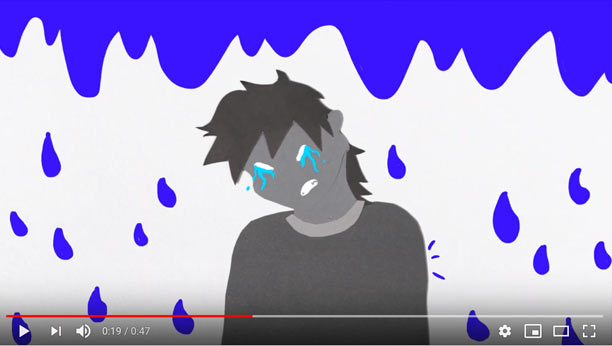
Emotional
Alex Schobitz
Corrie Parks, Visual Arts
“Emotional” is an animated self portrait depicting the struggle one faces when dealing with bipolar one disorder. The boy, a representation of the animator, has a series of rapid mood swings that plunge him into an uncontrollable surge of emotion. He must figure out a way to regain control of his feelings and get help. The piece was created through several different animation techniques. The greyscale paper dolls that functioned as the body for the protagonist were made by hand and given life through stop motion animation and use of a greenscreen. Layered on top of this, was digital animation for the rushing emotions, as well as digital rotoscoping for the boy’s expressions. The stop motion animation was done under a DSLR camera and then processed through Adobe Photoshop and Adobe Premiere Pro. The sound design for this piece was created in Ableton Live and Adobe Audition, and recrafted with permissions from FreeSound.org, and UMBC’s Sound Vault. This animation is intended to give viewers a glimpse into the tidal waves of emotions that so deeply affect not only the animator but anyone who struggles with bipolar one disorder.